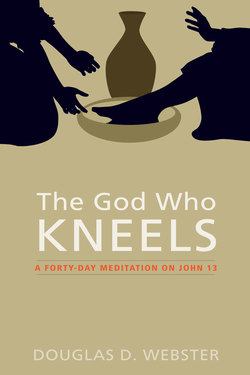Читать книгу The God Who Kneels - Douglas D. Webster - Страница 13
На сайте Литреса книга снята с продажи.
Day 8
ОглавлениеInscape
“You do not realize now what I’m doing . . .” John 13:7
Poet Gerard Manley Hopkins coined the term “inscape” to describe the unique character of an object or subject as it relates to its environment. Landscapes give us the horizon. Inscapes give us the essence. In John 13, John develops a theological inscape for the nature and practice of discipleship.
What gives foot-washing a cross-bearing significance? To answer this question, we take John’s seven deep meaning indicators and reapply them to Jesus’ followers. I believe it is important for us to see them all together. What I have done here is take what was said yesterday about Jesus and apply each theological marker to his followers. Here are the seven again: the Passover, kairos timing, redemptive love, the work of the devil, Jesus’ self-identity, his self-emptying, and his finished work. We are meant to transpose all seven indicators into a score to be played out in the life of the believer. We are playing “second fiddle” to the concert master, but what a privilege to play in this symphony!
We begin with the Passover, the event that underscores the meaning of redemption not only for the Savior but for his disciples. By divine design everything in our lives is to be framed by God’s redemptive action. Christ’s disciples embrace life sacramentally. Nothing lies outside the scope of God’s redemption, from menial household duties to evangelism. Because of Christ’s death we are continuously dying to self and to the old sin nature. In Christ we are made alive to the positive richness of life as intended and redeemed by God. We no longer live, but Christ lives in us, and the life that we now live we live by faith in the Son of God who gave himself for us (Gal 2:20). Salvation is grandly inclusive of all we are and will be.
The second deep meaning indicator, applied first to Christ and then to us, is time. As Jesus was conscious of his “hour,” we become conscious of a new sense of time and timing. Life is not primarily measured in minutes and months but in God’s providential will. The old chronology of the past, with its Rolex pride and self-importance, gives way to God’s rhythms of grace. Instead of pursing present-moment happiness we learn to abide in Christ moment by moment.
The third marker is love. Jesus showed the world the full extent of his love, and he calls his disciples to do the same. We are not only the recipients of his love but the agents of his love. We love because he first loved us.
The fourth shared factor between the Master and his disciples is the devil. The devil’s real presence in the upper room is consistent with his real presence in the world. Our struggle is not against flesh and blood, but “against the powers of this dark world” (Eph 6:12). Like a wounded animal the devil roams around seeking those he may devour (1 Pet 5:8).
The fifth deep meaning indicator, Jesus’ divine self-identity, is the basis of the believer’s resilient self-confidence. Because Jesus “knew the Father had put all things under his power, and that he had come from God and was returning to God,” we know who we are. We can say with the Apostle Paul, “I am what I am” by the grace of God (1 Cor 15:10).
The sixth parallel between Jesus’ cruciform identity and the disciple’s calling is self-denial. As Jesus laid aside his clothes as a precursor to laying down his life, we deny ourselves and take up our cross daily and follow him. His path to the cross is our path to the cross.
The seventh indicator focuses on the word finished, which is used when Jesus is done washing the disciples’ feet. It is the same word, the seventh word, Jesus uttered on the cross, when he said, “It is finished.” Between these two uses of the word finished we have the spectrum of Christlike service. The finished work of Christ reminds us of the unfinished work of our calling. It is precisely because of Christ’s gift of salvation by grace that we have a holy vocation. If God were not working in us to will and to act according to his good purpose, our service would be pointless. We cannot add to what Christ accomplished through the cross and the resurrection, but we can participate in his work. The finished work of Christ calls us to action. This is why the Apostle Paul said, “I fill up in my flesh what is still lacking in regard to Christ’s afflictions, for the sake of his body, which is the church” (Col 1:24).
These seven parallels between Jesus and his followers lay the foundation for the believer’s self-identity and deliberate action. This vivid picture of Jesus on bended knee is a defining moment for all of us who seek to follow Jesus. True spirituality is a grace-filled process that allows Christ’s life to take shape in ours by the power of the Holy Spirit. As we meditate on this scene, the inscape of Jesus’ action takes shape in us. The interior landscape belongs to Jesus and he calls us to follow his example. Out of his glorious riches may he strengthen us with power through his Spirit in our inner being, so that Christ may dwell in our hearts through faith (Eph 3:16–17).
Upper Room Reflection
What is the significance of applying the seven deep meaning indicators to Christ’s disciples, as well as to Christ?
How do these indicators expand our understanding of what it means to accept Jesus?
Which marker has the greatest impact for you?
What does it mean for us to say that Christ’s path to the cross is our path to the cross?
